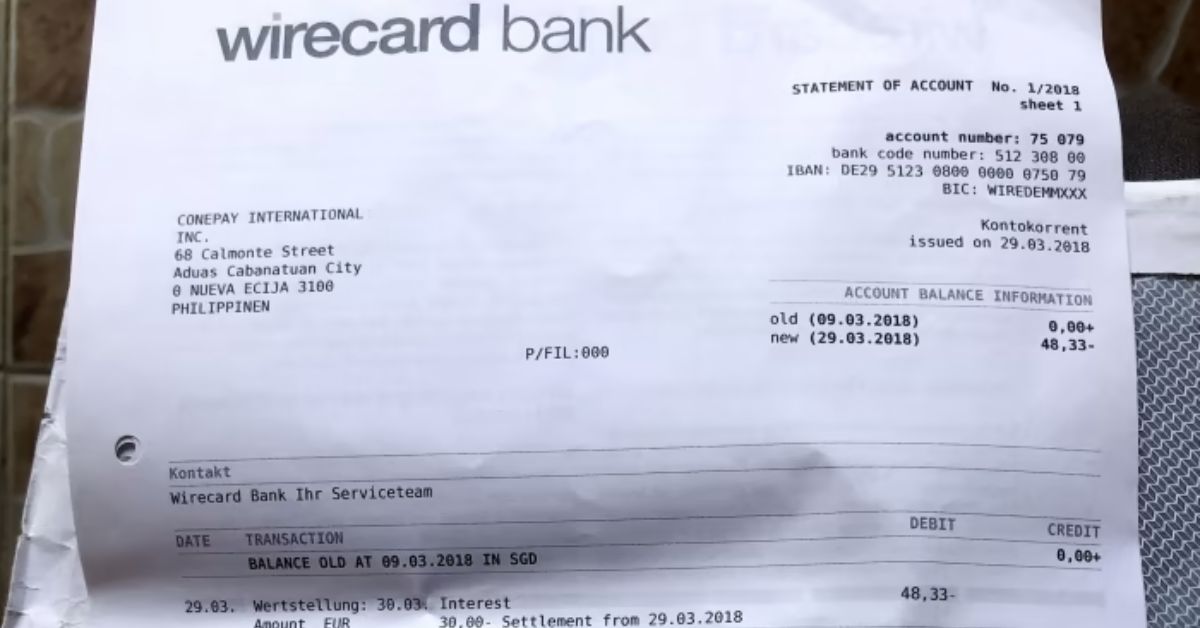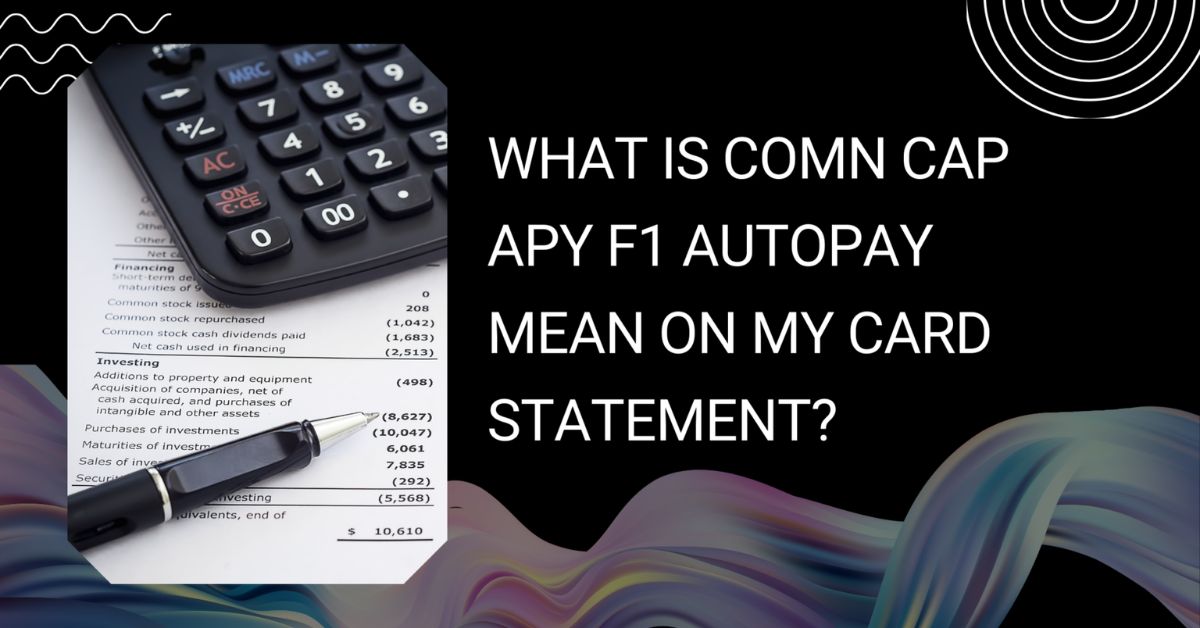Ever glanced at your credit card statement and found yourself scratching your head over a mysterious charge labeled “COMN CAP APY F1 AutoPay“? You’re not alone. This puzzling string of letters and numbers has left many cardholders wondering what’s going on with their finances. Don’t worry, though – we’re about to unravel this mystery and put your mind at ease.
In today’s fast-paced world, managing finances efficiently is crucial. With the rise of digital banking and automatic payments, our financial landscape has become more complex. But knowledge is power, and understanding these seemingly cryptic codes on your credit card statement can help you take control of your money like never before.
Let’s dive into the world of COMN CAP APY F1 AutoPay and discover what it really means for your wallet. We’ll explore its connection to Comenity Capital Bank, store credit cards, and the convenience of auto-payments. By the end of this article, you’ll be equipped with the know-how to decipher your statements like a pro and make informed decisions about your finances.
Cracking The Transaction Code: ACH-COMN-CAP-APY-F1
The transaction code “ACH-COMN-CAP-APY-F1” might look like a random jumble of letters, but each part carries significant meaning. Let’s break it down:
- ACH: This stands for Automated Clearing House, a network that processes electronic payments in the United States. It’s the digital highway your money travels on when you make electronic transfers.
- COMN: This is shorthand for Comenity, referring to Comenity Capital Bank, a financial institution specializing in store credit cards.
- CAP: Simply put, this stands for “Capital,” reinforcing the connection to Comenity Capital Bank.
- APY: In this context, APY likely stands for “AutoPay,” indicating an automatic payment setup.
- F1: This could be an internal code used by the bank for categorization or processing purposes.
When you see this code on your statement, it’s telling you that an automatic payment has been processed through the ACH network to a credit card issued by Comenity Capital Bank. This could be for a store-specific credit card you have, perhaps from one of your favorite retailers.
What should I do if I find comn-cap apy f1 in my statement for credit cards?
If you spot this charge on your statement and it catches you off guard, don’t panic. First, take a deep breath and gather your recent financial records. Check if you’ve recently made any purchases using a store credit card or if you’ve set up any auto-payments for such cards.
Next, review your agreements with any retail credit cards you might have. Many people forget that they’ve authorized automatic payments when signing up for these cards, especially if it’s been a while since they’ve used them.
If you’re still unsure, it’s always best to contact your bank or the customer service department of the store associated with the credit card. They can provide detailed information about the charge and confirm its legitimacy.
What is the reason for comn cap apy F1 appearing in my statement for credit cards?
The appearance of “comn cap apy F1” on your statement typically indicates that you’ve authorized automatic payments for a credit card issued by Comenity Capital Bank. This bank partners with numerous retailers to offer store-specific credit cards, often with perks like discounts, rewards, or special financing options.
When you sign up for these cards, you might opt for auto-pay to ensure you never miss a payment. This convenience feature automatically deducts the amount due from your linked bank account, helping you avoid late fees and maintain a good credit score.
For example, let’s say you have a store card from a popular clothing retailer. You might see a charge like this:
| Date | Description | Amount |
| 2024-07-15 | COMN CAP APY F1 AutoPay | $50.00 |
This would indicate that a $50 payment was automatically made to your store credit card on July 15, 2024.
How can I get rid of the comn cap apy F1 on the credit card bill?

If you’ve decided you no longer want automatic payments for your store credit card, you have options. Here’s what you can do:
- Contact Comenity Capital Bank directly. You can usually find their contact information on your credit card statement or the back of your card.
- Log into your online account for the specific store credit card and look for options to manage your payments. There’s often a section for “AutoPay” or “Payment Settings.”
- Reach out to the customer service department of the store associated with your credit card. They can guide you through the process of turning off auto-pay.
What should I do if I find comn-cap apy f1 in my statement for credit cards?
When you come across this charge, it’s essential to approach the situation methodically. Here’s a more detailed plan of action:
- Review your records: Go through your recent purchases and any store credit cards you might have. Sometimes, we forget about cards we don’t use often.
- Check your email: Look for any notifications about automatic payments being set up or processed. These emails often get overlooked in busy inboxes.
- Verify the amount: Does the charge amount match what you’d expect to pay for your credit card bill? If it’s wildly different, this could be a red flag.
- Contact the issuer: Reach out to Comenity Capital Bank or the associated retailer. They can provide specifics about the charge and confirm its validity.
- Document everything: Keep records of all your communications, including dates, times, and names of representatives you speak with.
- Monitor your account: Keep a close eye on your statements in the coming months to ensure everything is as it should be.
What is the reason for comn cap apy F1 appearing in my statement for credit cards?
The “comn cap apy F1” notation on your statement is essentially a fingerprint for automatic payments related to Comenity Capital Bank. This bank has carved out a niche in the financial world by partnering with a wide array of retailers to offer store-specific credit cards.
When you sign up for one of these cards, whether it’s for your favorite clothing store, a home improvement chain, or even a specialty retailer, you’re often presented with the option to set up auto-payments. This feature is designed to make your life easier by ensuring your bill is paid on time every month without you having to lift a finger.
Here’s a quick rundown of why you might see this charge:
- You’ve activated a new store credit card
- You’ve recently made a purchase using your store card
- It’s time for your monthly payment on an existing balance
How can I get rid of the comn cap apy F1 on the credit card bill?
If you’ve decided that automatic payments aren’t for you, or you simply want more control over when and how you pay your bills, you can definitely opt out. Here’s a more detailed approach to removing this charge from your statements:
- Gather your information: Before you make any calls or log into any accounts, have your credit card number, recent statement, and personal identification information ready.
- Online management: Most store credit cards now offer online account management. Log in to your account and look for sections labeled “Payments,” “AutoPay,” or “Account Settings.” You may be able to turn off automatic payments with just a few clicks.
- Mobile app: If the retailer or Comenity Bank offers a mobile app, check there for payment settings. Apps often provide easy-to-use toggles for features like auto-pay.
- Phone call: If you prefer speaking with a real person, call the customer service number on the back of your credit card. Inform them that you want to discontinue automatic payments. Be prepared to verify your identity.
- Confirmation: Whether you make the change online or over the phone, always request a confirmation email or letter. This documentation can be crucial if there are any issues in the future.
- Follow-up: After making the change, monitor your next statement to ensure the automatic payment has indeed been canceled.
More Post
Comenity Capital Bank and Its Role
Comenity Capital Bank plays a unique and significant role in the world of consumer finance, particularly when it comes to retail credit cards. Understanding this bank’s function can shed light on why you’re seeing those mysterious charges on your statement.
Brief Introduction to Comenity Capital
Comenity Capital Bank isn’t your typical corner bank. You won’t find branches on Main Street or ATMs in your local grocery store. Instead, this financial institution operates behind the scenes, powering the credit cards of many of your favorite retailers.
Founded with the goal of providing specialized financial services, Comenity has become a major player in the store credit card market. They partner with a diverse range of businesses, from clothing retailers to home improvement stores, offering tailored credit solutions that benefit both the merchants and their customers.
The Bank’s Services and Role
Comenity’s primary service is issuing and managing store-specific credit cards. When you apply for a credit card at your favorite department store or sign up for financing on a big purchase, there’s a good chance Comenity is working behind the scenes.
Here’s what Comenity typically offers:
- Credit underwriting: They assess applications and determine credit limits.
- Account management: Handling payments, interest calculations, and customer service.
- Rewards programs: Many store cards offer points, cashback, or other perks, which Comenity helps manage.
- Special financing: Options like deferred interest or low introductory rates are often part of their offerings.
By partnering with Comenity, retailers can offer credit to their customers without having to manage the financial complexities themselves. This allows stores to focus on what they do best – selling products – while still providing the convenience of store-branded credit.
Why Is This Code on My Bank Statement?

Seeing “COMN CAP APY F1 AutoPay” on your bank statement is like finding a breadcrumb trail leading back to a financial decision you made, possibly some time ago. This code appears for several reasons, all tied to your interaction with Comenity Capital Bank and the store credit cards they manage.
You’ve Authorized Payments Through Comenity Capital Bank
The most common reason for this code to appear is that you’ve set up automatic payments for a store credit card. When you opened the card, you likely had the option to have your monthly bill automatically deducted from your checking account. This convenience feature ensures you never miss a payment, helping you maintain a good credit score and avoid late fees.
For instance, if you have a store card for a popular electronics retailer, you might have authorized auto-pay when you financed that new 4K TV. Each month, when the payment is due, the system automatically processes the transaction, leading to the “COMN CAP APY F1 AutoPay” entry on your statement.
Might be You’ve Utilized a Store Card
Another scenario where you’d see this code is if you’ve recently made a purchase using a store-specific credit card managed by Comenity. Even if you haven’t set up auto-pay, the code might appear when you make a manual payment towards your balance.
Let’s say you have a store card for a fashion retailer. You bought a new outfit for a special occasion and decided to pay off the balance immediately. When you make that payment, it’s processed through Comenity’s system, potentially triggering the appearance of this code on your statement.
It’s an Auto-Payment
The “AutoPay” part of the code is a dead giveaway – this charge represents an automatic payment. Auto-payments are a double-edged sword in the world of personal finance. On one hand, they ensure you never miss a payment, which is great for your credit score and peace of mind. On the other hand, they can lead to overdraft fees if you’re not careful about maintaining sufficient funds in your account.
Here’s a quick pros and cons list for auto-payments:
| Pros | Cons |
| Never miss a payment | Potential for overdraft if funds are low |
| Saves time and hassle | Less control over payment timing |
| Can improve credit score | May pay more than minimum due automatically |
| Avoid late fees | Could overlook fraudulent charges |
Who Is This Comenity Capital Bank, Anyway?
You might be wondering why you’re dealing with a bank you’ve never heard of. Comenity Capital Bank is what’s known as a specialized financial services provider. They don’t operate like traditional banks with physical branches and general banking services. Instead, they focus on partnering with retailers to provide store credit cards and other financial products.
Comenity has been around since 1986, originally under a different name. Over the years, they’ve grown to become one of the largest providers of private label credit cards in the United States. They work with hundreds of well-known brands across various industries, from fashion to home improvement to travel.
Here are some key points about Comenity Capital Bank:
- They’re regulated by the Federal Deposit Insurance Corporation (FDIC), just like traditional banks.
- Comenity manages millions of card accounts across the United States.
- They offer both store-only cards and co-branded cards that can be used anywhere.
- Many of their cards come with special perks like discounts, rewards, or special financing options.
While you might not interact directly with Comenity often, they play a significant role in the background of many retail financial transactions.
Can I Dispute This Charge?
If you see a “COMN CAP APY F1 AutoPay” charge on your statement that you don’t recognize or believe is incorrect, you absolutely have the right to dispute it. However, before you jump into the dispute process, it’s important to do a bit of detective work.
First, double-check your records. Look through your wallet for any store credit cards you might have forgotten about. Review your email for any notifications about automatic payments or account activity. Sometimes, these charges are legitimate but simply slipped our minds.
If you’re still convinced the charge is erroneous, here’s what you can do:
- Contact your bank: Start by calling the customer service number on the back of your debit card or on your bank statement. Explain the situation and ask for more information about the charge.
- Reach out to Comenity: Since the charge is related to Comenity Capital Bank, you can also contact them directly. They can provide details about which store card the charge is associated with.
- File a formal dispute: If you’ve confirmed that the charge is indeed unauthorized, you can file a formal dispute with your bank. Under the Fair Credit Billing Act, you have the right to dispute charges you believe are incorrect.
- Provide documentation: Be prepared to provide any relevant documentation to support your claim. This could include statements showing you’ve never had a transaction with the associated retailer.
- Follow up: Disputes can take some time to resolve. Make sure to follow up regularly and keep all communication records.
Frequently Asked Questions
Why am I seeing this charge if I don’t have an account with Comenity Capital Bank?
This is a common question, and the answer lies in the nature of store credit cards. While you might not have directly opened an account with Comenity Capital Bank, you may have a store credit card that’s managed by them. Many retailers partner with Comenity to handle their credit card programs.
For example, if you have a credit card for a popular clothing store or home goods retailer, it might be issued and managed by Comenity, even though it bears the store’s branding. When you make payments on these cards, especially if you’ve set up auto-payments, you’ll see the Comenity-related charge on your statement.
How can I confirm if the ACH-COMN-CAP-APY-F1 charge is legitimate?
To verify the legitimacy of this charge, follow these steps:
- Review your recent credit card applications and approvals.
- Check your wallet for any store credit cards you might have forgotten about.
- Look through your email for any notifications about new accounts or payment confirmations.
- Contact your bank for more details about the specific charge.
- Reach out to Comenity Capital Bank directly to inquire about any accounts in your name.

Jordan Lee, a tech enthusiast and the founder of Innovate Tech Solutions, brings a wealth of knowledge to the tech industry. With a strong background in software development and digital marketing, Jordan crafts solutions that drive innovation. His passion for technology fuels his commitment to helping businesses thrive in the digital landscape.
